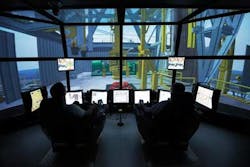Russell McCulley
Senior Technical Editor
Over the past several years, supermajor BP has built up reserves by acquiring acreage in some of the world's most challenging deepwater basins, including the Gulf of Mexico's ultra-deepwater Paleogene, Egypt's West Nile Delta, and offshore Azerbaijan, where reservoir pressures and temperatures exceed the industry's current technology capacity. It stands to reason, then, that BP has taken a leading position in the effort to develop that technology.
Early last year, the company announced Project 20K, a multi-pronged research and development program to "develop, by the end of the decade, the technologies to be able to drill, complete, produce, and intervene in deepwater reservoirs that have (pressures of) 20,000 psi at the mudline," as BP's Project 20K leader in Houston, Kevin Kennelly, puts it. "Today's limit is at 15,000 psi. So this is an evolution up to the next spec break in equipment."
The Project 20K R&D effort encompasses four main areas of focus: well design and completions; rigs, risers, and BOPs; subsea production systems; and well intervention and containment. In addition to the 20,000-psi target, the equipment will need to withstand reservoir temperatures as high as 350°F (175°C). About 70 BP engineers are assigned to the program, most of them in Houston, where the project team is based.
In November 2012, BP awarded its initial Project 20K contracts to KBR and FMC Technologies. The former was tasked with developing program execution and management plans for the project, including cost (which Kennelly will only say is "in the range of billions of dollars") and schedule estimates, risk assessment, and technical designs. FMC was enlisted to work with BP to design and develop the subsea production equipment, including a 20,000-psi subsea tree and a high integrity pressure protection system (HIPPS).
Last February, the company announced that it had selected Maersk Drilling to be its collaborator on the program's rig, risers, and BOP design segment. Maersk's team, in both Houston and Copenhagen, has been performing engineering studies to select the rig and equipment design for the task. The new rigs are expected to include advanced operating systems, real-time BOP monitoring, and "significantly enhanced mechanical capabilities of the BOP, rig structures, and piping systems," BP said at the time of the announcement. Engineers are using design criteria geared to the US Gulf of Mexico, where BP is appraising the Paleogene Kaskida and Tiber prospects.
"We are looking at a deepwater unit with a high hook load capacity and high variable deck load capacity," says Maersk chief technology officer Frederik Smidth. Although the team has yet to make a formal recommendation, engineers are leaning toward a drillship concept. "Originally, we were open to both a semi and a ship," he says. "But as it looks right now, due to the functional requirements, it looks like we will end up with a ship-shaped hull.
"Ultimately, the intention for both parties, I hope, is to continue the work, and that it will end up in contracts for a number of rigs with good, long drilling contracts."
Kennelly agrees: "The idea is, we design one and build several. And they can be used anywhere around the world. The big driver here is reservoir pressure, not water depth. We're not breaking new ground with water depth; we're designing this equipment for 10,000-ft water depth. This project is designed for deepwater applications, but we're targeting a range."
Hook load capacity on the new vessels, he says, could reach 3 million pounds, well above the current capacity of 2.5 million pounds.
Industry evolution
High-pressure/high-temperature (HP/HT) technology has evolved incrementally, with higher capacity achieved first in onshore applications, Kennelly explains.
"The way the industry has evolved, it started at 5,000-psi equipment onshore, and then it went to 10,000 psi onshore. We took the 5,000-psi equipment and marinized it for offshore. When they went to 15,000 psi onshore, we took the 10,000-psi equipment and marinized it, so it could be used in deepwater. Today, there's 20,000-psi equipment onshore, but there's no 20,000 psi capability offshore. It's limited to 15,000. That's why we say it's an evolution."
Raising the bar to 20,000 psi offshore will follow a similar pattern of marinization "in overall terms," he says. "You have the design, the build, the qualification testing, and then you put it into service. Those fundamental steps are the same. But we're going to do some things different in 20K. We're going to do a lot more qualification testing on the engineered systems, not just components or individual pieces of equipment. The reason for that is we want to be absolutely sure that the equipment is safe, that it's reliable, and that it operates to its intended function. So there's quite a bit more qualification testing that we're going to do on this project."
In August, 2012, BP pledged $100 million to establish the BP International Centre for Advanced Materials, an academic program devoted to the research and development of new materials for offshore applications, including HP/HT. The University of Manchester's Faculty of Engineering and Physical Sciences serves as a hub for the program, which also funds researchers at the University of Cambridge, Imperial College London, and the University of Illinois at Urbana-Champaign. The 10-year investment program will sponsor research into advanced materials and is expected to support 25 new academic posts, along with 100 post-graduate researchers and 80 post-doctoral fellows. The program will examine the adaptation of materials developed for other industries, including aerospace, for the offshore energy realm.
"Our work has shown us that we need to go beyond just making things bigger and heavier," Kennelly says. "We're looking at new, lightweight, high-strength materials that can withstand these higher pressures and temperatures up to 350°F. And we're looking at ways to incorporate inherently safer sealing components and designs."
Testing will be conducted at pressures and temperatures higher than those found in the reservoirs, he adds: "There are testing venues out there capable of doing that, but we think there will be some upgrading involved."
Project 20K research includes methods to minimize human error in drilling and production operations by improving what Kennelly calls the "man-machine interface." One example is the use of shape rather than color alone to distinguish buttons or switches. Color blindness, he notes, is fairly common in men, making color-coded buttons harder to identify in an emergency. Advanced systems will also rely more on computers to assist in decision-making.
"That's one of the things we're looking at a lot, the man-machine interface," Kennelly says: "How, when we can, do we take the man out of the decision-making process? And if we can't, how do we get the right information to the person early enough, so that we know he will make the right decision?"
Capacity and cost
Project 20K rig design has been largely driven by the load capacity necessary to conduct drilling operations under the more rigorous reservoir conditions, says Smidth.
"A semi could certainly do the job, and in some aspects might even be an advantage," he says. "But the issue is that a semi capable of carrying the load that we're talking about would be a huge semi. From a cost perspective, we are almost certain that a ship is a better solution.
"The well design is the basis, obviously," he continues, "and we look at what casing will need to be run, what extra services we need to provide, and so on. So it's not only the pressure-bearing equipment. That is pretty straightforward. But these wells require very long and heavy casing strings to be able to drill them efficiently, meaning that we need high hook load capacity. What number we are going to end up with we do not know yet. But it's a high number."
Working closely with BP has given Maersk an opportunity to identify potential inefficiencies, information that the company plans to use to help improve margins with the new rigs, Smidth says.
"The intention is to come up with a rig that can safely drill in 20,000-psi conditions. But beyond that, we also expect to learn what brings value to our client, the oil company." A significant reduction in non-productive time – for example, employing new material technology that would enable less frequent seal replacements – could help offset the inevitably higher day rates of the next-generation drilling rigs, he says.
"I think it goes without saying that these units are going to be more expensive than traditional 15,000-psi rigs," Smidth said. "Our goal, together with BP, is to design a rig so that we can construct a 20,000-psi well at more or less the cost of a 15,000-psi well. Obviously, you will need a higher day rate for a more expensive unit. But if we can do it faster and smarter, then we will reduce non-productive time. There's a lot of knowledge there that should be harvested, and shared."
With Project 20K, he added, "we now have access, with BP, to look at that non-productive time to see if there's anything we can do from a rig perspective to minimize that, or reduce the risk of that kind of non-productive time from occurring."
Industry solutions
When the various pieces of Project 20K come together and the new rigs set to work, perhaps as early as 2018, reaching the safety targets that BP has set forth will ultimately come down to properly trained personnel. Much of that training will be done at the Maersk Training complex in Svendborg, Denmark, where the company recently installed a drilling simulator that can support 20,000-psi instruction. The complex includes a rig control room simulator, engine room simulator, and crane simulators for integrated crew training.
Kennelly says much of the 20K tool kit will draw on proven "but enhanced" technologies.
"KBR is working with BP and other contractors to develop the functional specifications for all equipment," he said. "Once we do that, we work with the vendors to help develop equipment that complies with those specs."
There could be a substantial payoff should BP be the first to break deepwater HP/HT barriers. BP's offshore acreage alone could hold 10-20 Bbbl in HP/HT reservoirs, according to the company's estimates. But Kennelly insists that "we're not out to establish a competitive advantage. We're out to develop industry solutions.
"In our case, we're at the very forefront of deepwater discoveries that require 20,000 psi, compared to some of our competitors. But from a materiality scope and scale, there wouldn't be enough business for the vendors to be interested in equipment only for BP. Again, we want to develop solutions that the industry can use, and we have a need for that sooner rather than later.
"Our commitment is to develop this new technology, and what's absolutely paramount to us is that it's safe, reliable, and operates to its intended design. That's where our commitment is for the whole team. What's unique here, I think, is that this is a joint project between our global projects organization and our global wells organization.
"And we've brought some of our key vendors in very, very early. We spent a lot of time looking at the contractors we wanted to work with. We wanted to make sure they had the same aligned vision as us, the same ideas on safety, reliability, on performance, and approach to design. And I'm very proud of who we're working with."





